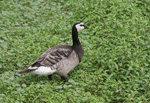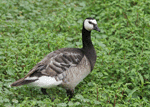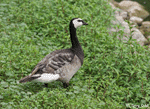| Length: 26 inches | Wingspan: 48 inches | Seasonality: Non-resident in South Dakota |
| ID Keys: Dark head, neck, and breast, white face and throat, pale gray back with dark bars | ||
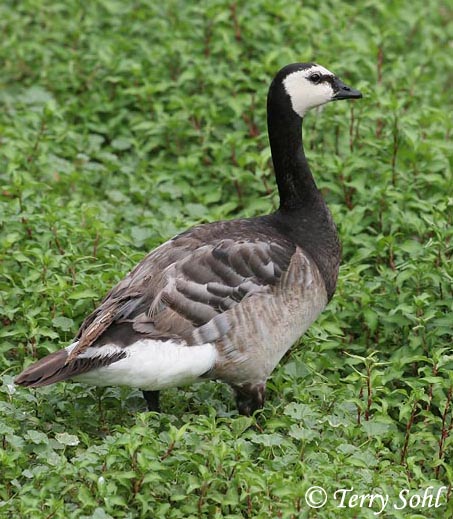 The
Barnacle Goose is just a visitor to most of North America. They breed
in eastern Greenland and select high-latitude islands in the North Atlantic,
and overwinter in England, Scotland, the Nethlerlands, and other locations
in northern Europe. Birds breeding in Greenland sometimes stray to
eastern Canada and the northeastern United States, where the vast majority
of North American sightings of the species have occurred. Barnacle
Geese are also popular aviary birds, so many individuals spotted in the U.S.
are likely from a domestic origin.
The
Barnacle Goose is just a visitor to most of North America. They breed
in eastern Greenland and select high-latitude islands in the North Atlantic,
and overwinter in England, Scotland, the Nethlerlands, and other locations
in northern Europe. Birds breeding in Greenland sometimes stray to
eastern Canada and the northeastern United States, where the vast majority
of North American sightings of the species have occurred. Barnacle
Geese are also popular aviary birds, so many individuals spotted in the U.S.
are likely from a domestic origin.
Habitat: During the summer breeding season, nests in rocky areas with cliffs and other impediments to predators. In the winter, they are found in coastal marshes and wetlands.
Diet: Mostly vegetarian, feeding heavily on grasses and sedges, especially during the summer breeding season. Also feeds on aquatic vegetation, and will sometimes feed on insects and small mollusks.
Nesting: Nests in colonies. The nest of a Barnacle Goose is usually placed in a crevice or shelf on a rocky cliff, and is made of grasses and other vegetative material, lined with down. Upon hatching, young are led to nearby water below, where they are tended to (but not fed by) the parents.
Interactive eBird Map: Click to access an interactive eBird map of Barnacle Goose sightings
Song: Loud, short honking noises are common.
Migration: Migratory, breeding in select locations in the North Atlantic and Arctic portions of Eurasia, including eastern Greenland, Svalbard, and islands in northwestern Russia. Winters in Northern Europe.
Similar Species: Distinctive in plumage when seen well, most similar to Canada Goose, Cackling Goose. Brant
Conservation Status: There are currently no perceived major threats to Barnacle Goose populations, and the IUCN lists them as a species of "Least Concern". Populations appear to be increasing.
Further Information: 1) BTO.org - Barnacle Goose
2) Oiseaux.net - Barnacle Goose
3) Ducks Unlimited - Barnacle Goose
Photo Information: Photo of captive bird - Taken by Terry Sohl
| Click below for a higher-resolution map |
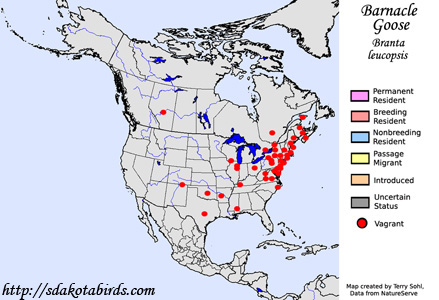 |
| South Dakota Status: Non-resident in South Dakota |
Additional Barnacle Goose Photos
Click for a higher-resolution version of these photos
